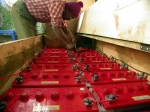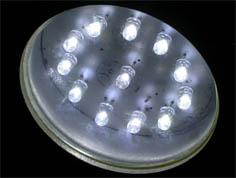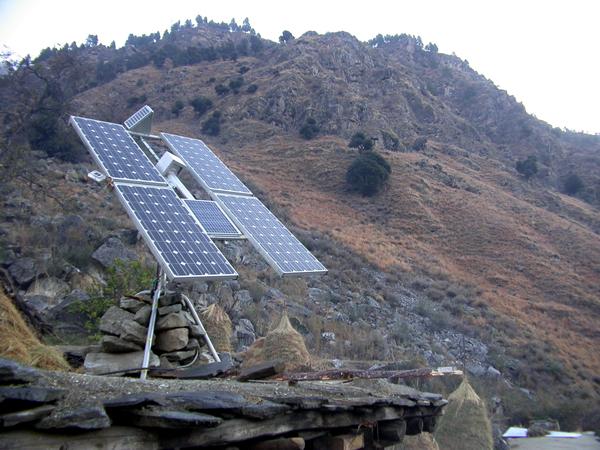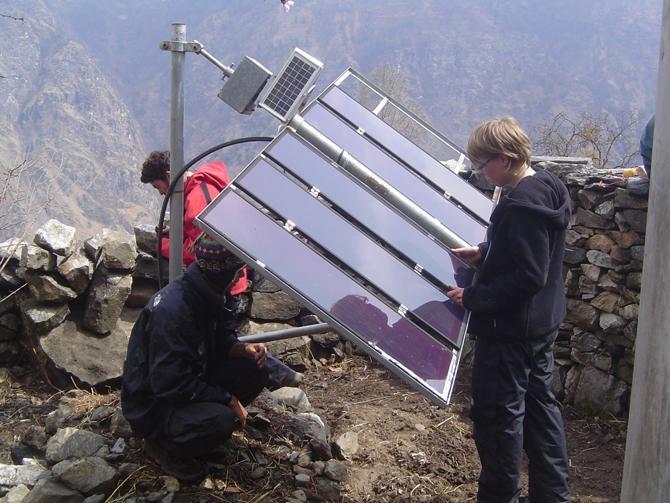Related Pages
LightSolar Photo Voltaic
» Solar Home System
» Cluster System
» 2-Axis Tracking System
Pico-Hydro
Wind Energy
General Poll - Light
| 2-Axis Tracking System |
 |
 |
 |
|
RIDS-Nepal has installed and used its own designed solar PV central tracking systems since 2002. The central tracking system is RIDS-Nepal’s most complex designed solar PV system in use. It is big enough to provide power for a whole village. If the houses in a village are built very close to each other, and with people from mainly the same caste, the central tracking system presents a technically, socially, and economically viable solution. The community as a whole takes the responsibility to participate in the installation of the village system, the maintenance of the system by the trained local people and the collection of monthly user fees.
Figure 1: A Schematic Diagram showing 2-Axis Central Tracking System System SpecificationsThis system is comprised of the following major components:Solar PV Modules with TrackerSee a 2 Axis Solar PV Tracker in action at Tulin Village, Humla
Charge ControllerBattery Bank The battery bank is used to store the solar energy generated during the day for the use of lights and other electric equipment during the evenings or the days when the sun is not shining. The battery banks for the cluster and central tracking systems have flooded lead acid batteries, connected in series, to provide a 24VDC, and parallel, to provide the needed Ah (Ampere hours) capacity for the designed system. These batteries need periodical topping up of distilled water in order to keep them well maintained and long lasting. The battery banks for the SHS have sealed glass-matt gel batteries which are maintenance free, that means it does not need to be topped up with distilled water. The battery bank is used to store the solar energy generated during the day for the use of lights and other electric equipment during the evenings or the days when the sun is not shining. The battery banks for the cluster and central tracking systems have flooded lead acid batteries, connected in series, to provide a 24VDC, and parallel, to provide the needed Ah (Ampere hours) capacity for the designed system. These batteries need periodical topping up of distilled water in order to keep them well maintained and long lasting. The battery banks for the SHS have sealed glass-matt gel batteries which are maintenance free, that means it does not need to be topped up with distilled water. InverterDC Loads In all village based solar PV systems, where elementary indoor lighting is the main aim, only DC loads are considered. The DC loads are WLED lamps developed and under the supervision of RIDS-Nepal in Nepal manufactured. Each WLED lamp consist of 12 high quality, original Nichia diodes (often from the type NSPW510DS) , consuming only 1 watt power. In all village based solar PV systems, where elementary indoor lighting is the main aim, only DC loads are considered. The DC loads are WLED lamps developed and under the supervision of RIDS-Nepal in Nepal manufactured. Each WLED lamp consist of 12 high quality, original Nichia diodes (often from the type NSPW510DS) , consuming only 1 watt power.AC Loads AC loads are PCs, laptops, printers, CFL lamps, laboratory and test equipment, as well as rechargeable batteries for the WLED torches the RIDS-Nepal staff are using. AC loads are PCs, laptops, printers, CFL lamps, laboratory and test equipment, as well as rechargeable batteries for the WLED torches the RIDS-Nepal staff are using.Benefits The 2-axis solar tracking system has the potential, if properly maintained and adjusted, to increase the annual energy generation up to 35%-38%, compared to the a same sized solar PV array on a year around fixed angle position. RIDS-Nepal’s practical experience, based on actual monitored field data from the village and RIDS-Nepal Humla office systems since 2004 show, that an annual increase between 28% (in Tulin village) and 32% (in RIDS-Nepal’s High Altitude Research Station office in Simikot, Humla), have been achieved. The reasons for these lower values achieved are the non-ideal seasonal tilt angle of the solar PV array, which is ideally adjusted twice every month, the non-periodical cleaning of the dusty, snow covered or wet solar PV modules, as well not cutting the surrounding bushes and tree branches which can cause shadows on the PV modules and thus lower their power output. All these issues are not due to technical problems but due to user awareness and not keeping strictly to the users’ defined maintenance schedule. The 2-axis solar tracking system has the potential, if properly maintained and adjusted, to increase the annual energy generation up to 35%-38%, compared to the a same sized solar PV array on a year around fixed angle position. RIDS-Nepal’s practical experience, based on actual monitored field data from the village and RIDS-Nepal Humla office systems since 2004 show, that an annual increase between 28% (in Tulin village) and 32% (in RIDS-Nepal’s High Altitude Research Station office in Simikot, Humla), have been achieved. The reasons for these lower values achieved are the non-ideal seasonal tilt angle of the solar PV array, which is ideally adjusted twice every month, the non-periodical cleaning of the dusty, snow covered or wet solar PV modules, as well not cutting the surrounding bushes and tree branches which can cause shadows on the PV modules and thus lower their power output. All these issues are not due to technical problems but due to user awareness and not keeping strictly to the users’ defined maintenance schedule. 2-Axis Central Tracking Systems in HumlaRIDS-Nepal has since 2002 installed a total of thirteen 2-axis solar PV tracking system. Four 2-axis solar PV tracking systems are installed in Kathmandu, Nepal’s capital, providing the main power generation for the RIDS-Nepal main office, while nine 2-axis solar PV tracking systems are installed in various villages, a high school and a health post in Humla district, RIDS-Nepal’s main working area in the remote, high altitude north-west of Nepal.In the following some village based 2-axis solar PV tracking systems are identified.
Tulin VillageTulin village is located at latitude 29°59'23.48" North, longitude 81°46'57.05" East, at an altitude of 2,377 meters above sea level. The village has 28 households and is electrified with one 2-axis solar PV tracking systems with a rated capacity solar PV module size of 300WR, a 24 VDC battery bank with a capacity of 400Ah, with deep cycle, flooded lead-acid batteries. The system is a DC system, as no AC loads are used. Each house is connected through underground cabling to the central located battery bank and has 3 WLEDs lamps as their DC load. This village solar PV system is in use since 2006. Figure 2: Single 2-Axis Tracker in Tulin Village HARS or RIDS-Nepal office in SimikotRIDS-Nepal office (HARS) in Simikot village is located at latitude 29°58'22.07" North, longitude 81°49'05.63" East, at an altitude of 3,000 meters above sea level. The system is an AC system as the RIDS-Nepal staff use PCs, printers, laptops and other AC electric equipment for various test and lab equipment. This system is powered by with three 2-axis solar PV tracking systems with total rated capacity of 900WR, a 24 VDC battery bank with a capacity of 800Ah, with deep cycle, flooded lead-acid batteries. A pure sinusoidal wave inverter (800W Joker from the Swiss company Studer) converts the needed AC power from the DC battery bank. This solar PV system is in use since April 2004 and has provided uninterruptible AC electricity since.Figure 3: Three 2-Axis Tracker in Simikot Village (HARS) Heath Post in Syada VillageSyada village is located at latitude 29°59'2.67" North, longitude 81°46'0.5" East and at an altitude of 2,727 meters above sea level. The system is an AC system as the Health Post uses the PCs, CFL lights for its treating rooms and other electric equipment. This system is powered by with two 2-axis solar PV tracking systems with total rated capacity of 228WR, a 24 VDC battery bank with a capacity of 200Ah, with deep cycle, flooded lead-acid batteries. A pure sinusoidal wave inverter (200W Joker from the Swiss company Studer) converts the needed AC power from the DC battery bank. This solar PV system is in use since June 2006 and has provided uninterruptible AC electricity since. Figure 4: DC 2-Axis Tracker in Syada Health Post The Chauganphaya High SchoolChauganphaya High School is located at latitude 30°00'35.62" North, longitude 81°46'1.67" East and at an altitude of 2,555 meters above sea level. This system is powered by with two 2-axis solar PV tracking systems with total rated capacity of 228WR, a 24 VDC battery bank with a capacity of 200Ah, with deep cycle, flooded lead-acid batteries. The system is a DC system as the High School solar PV system provides 93 WLED lamps to all the students’ and teachers’ hostel rooms. This solar PV system is in use since January 2003 and has provided light for the students and teachers with a few minimal interruptions due to non adherence of the maintenance schedule by the local teachers.Figure 5: Two DC 2-Axis Trackers in Chauganphaya School |